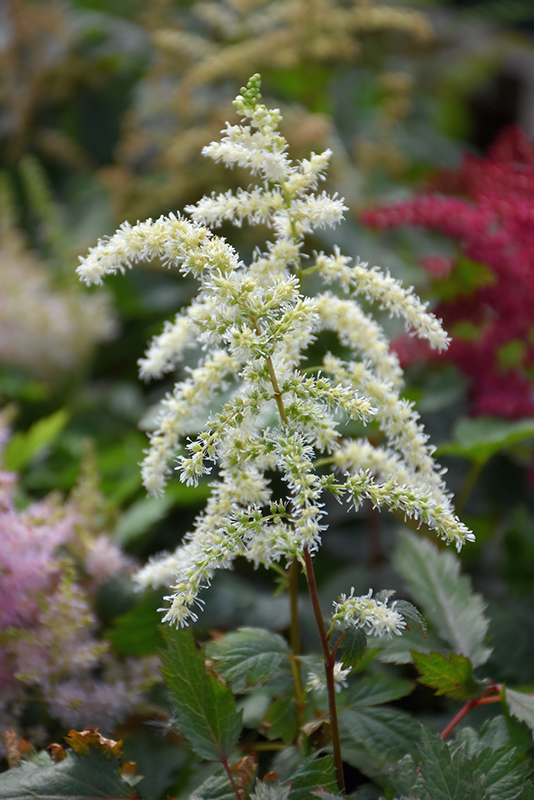>> Home
Cappuccino Astilbe
Astilbe x arendsii 'Cappuccino'
Plant Height: 15 inches
Flower Height: 24 inches
Spacing: 15 inches
Sunlight:
![]()
![]()
Hardiness Zone: 2
Other Names: False Spirea
Description:
Striking, large white plumes rising above contrasting, black-bronze leaves; perfect in a shady spot with dappled light; prefers moisture so water regularly for abundant flowers and nice foliage; divide every 2 to 3 years in early spring
Ornamental Features
Cappuccino Astilbe has masses of beautiful plumes of white flowers at the ends of the stems from early to mid summer, which are most effective when planted in groupings. The flowers are excellent for cutting. Its attractive glossy ferny compound leaves emerge coppery-bronze in spring, turning dark green in color with showy coppery-bronze variegation and tinges of black throughout the season. The dark red stems are very colorful and add to the overall interest of the plant.
Landscape Attributes
Cappuccino Astilbe is an herbaceous perennial with an upright spreading habit of growth. Its relatively fine texture sets it apart from other garden plants with less refined foliage.
This is a relatively low maintenance plant, and is best cleaned up in early spring before it resumes active growth for the season. It is a good choice for attracting birds and butterflies to your yard, but is not particularly attractive to deer who tend to leave it alone in favor of tastier treats. It has no significant negative characteristics.
Cappuccino Astilbe is recommended for the following landscape applications;
- Mass Planting
- General Garden Use
- Container Planting
Planting & Growing
Cappuccino Astilbe will grow to be about 15 inches tall at maturity extending to 24 inches tall with the flowers, with a spread of 18 inches. When grown in masses or used as a bedding plant, individual plants should be spaced approximately 15 inches apart. It grows at a medium rate, and under ideal conditions can be expected to live for approximately 10 years. As an herbaceous perennial, this plant will usually die back to the crown each winter, and will regrow from the base each spring. Be careful not to disturb the crown in late winter when it may not be readily seen!
This plant does best in a location that gets morning sunlight but is shaded from the hot afternoon sun, although it will also grow in full shade. Keep it away from hot, dry locations that receive direct afternoon sun or which get reflected sunlight, such as against the south side of a white wall. It requires an evenly moist well-drained soil for optimal growth. It may require supplemental watering during periods of drought or extended heat. It is very fussy about its soil conditions and must have rich, acidic soils to ensure success, and is subject to chlorosis (yellowing) of the foliage in alkaline soils. It is somewhat tolerant of urban pollution, and will benefit from being planted in a relatively sheltered location. Consider applying a thick mulch around the root zone over the growing season to conserve soil moisture. This particular variety is an interspecific hybrid. It can be propagated by division; however, as a cultivated variety, be aware that it may be subject to certain restrictions or prohibitions on propagation.
Cappuccino Astilbe is a fine choice for the garden, but it is also a good selection for planting in outdoor pots and containers. With its upright habit of growth, it is best suited for use as a 'thriller' in the 'spiller-thriller-filler' container combination; plant it near the center of the pot, surrounded by smaller plants and those that spill over the edges. Note that when growing plants in outdoor containers and baskets, they may require more frequent waterings than they would in the yard or garden.
